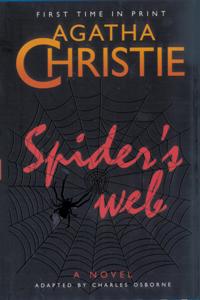|
|
| Cat Among the Pigeons (Photo credit: Wikipedia) |
Title: Cat Among the Pigeons
Author: Agatha Chirstie
Main Characters: Miss Vanisttart, Miss Bulstrode, Miss
Chadwick, Miss Rich, Ann Shapland (Angelica de Toredo), Miss Johnson, Miss
Rowan, Miss Blake, Adam Goodman (Ronnie), Colonel Pikeaway, Derek, Inspetor
Kelsey, Prince Ali Yusuf, Bob Rawlinson, Mrs. Upjohn, Julia Upjohn and Joan
Sutcliffe (Mrs. Sutcliffe), Jennifer Sutcliffe, Briggs, Mr. Robinson, M. Hercule
Poirot, Shaista and Madmoiselle Blanche.
Description of one of the main characters : Mrs. Upjohn is
the mother of Julia Upjohn. She is an extremely intelligent and clever woman. She has been a secret agent herself and has worked for the 'Intelligence'.
She has the talent to identify criminals in a crowd. She is a very strange
woman. She exhibits her strangeness by travelling to Anatolia from England in a bus. She is not very rich. She is a cheerful person. She is a keen observer and a
quick learner.
Whom I like and why: I like Julia Upjohn very much. She is just as smart and
clever as her mother, Mrs. Upjohn. She has alot of common sense and presence of mind when
it comes to a problem. Though everybody knew, including Inspector Kelsey, that
somebody tried to exchange Jennnifer's bat and that the first murder happened at the
sports pavilion, nobody could put two and two together and arrive at the
conclusion, that there must be something hidden in Jennifer’s tennis racquet which was kept in the sport's pavillion, except Julia Upjohn. She is the one of to discover the lost jewels of Prince Ali
Yusuf and bring it to the notice of M. Hercule Poirot. These support the fact that
Julia Upjohn is the only person, excluding M. Poirot, who pushed the cases of the murders and
burglary forward.
Whom I Dislike and Why: I dislike Inspector Kelsey. He is of no use. Although he was
telling others that he was trying to solve the mysterious cases, he did nothing
but roam around the school questioning everyone uselessly. Only after M. Poirot entered the scene, the cases got cleared
up one by one in Poirot’s own way.
Setting/Theme of the story: Prince Ali Yusuf, sensing that he would soon die, entrusts a
bag full of precious jewel stones, which the Sheiks have had for centuries, to
his personal pilot and best friend, Bob Rowlinson, asking him to somehow transport
it to a new and safe place. Bob Rowlinson after racking his brains on how to
send it safely somewhere, decides that London is the safest place for it as no
one would suspect. Without his sister’s knowledge, he packs it in her bag and sends his
sister, Mrs. Sutcliffe, off to London. During the revolution, when Ali Yousuf,
the Prince of Ramat, tries to escape with Bob Rawlinson, they hit the mountains
of Ramat. The plane crashes and they die. Mrs. Sutcliff hears the news and gets
highly upset. She decides to send Jennifer, her daughter, to Meadowbank, a residential school, after a
theft attempt in her house.
Meanwhile, Mr. Pikeaway sends a lad named Ronnie to
Meadowbawk as Princess Shaita, the neice of Emir Ibrahim and the cousin of
late Prince Ali Yusuf, comes to studyat Meadowbank. Ronnie comes with the name
of Adam Goodman. He employs himself as the assistant gardener of Meadowbank.
The
summer term begins normally at Meadowbank. There are two new teachers in Meadowbank - Mademoiselle Blanche, a french teacher and Mrs. Springer, the sports incharge. One day, Mrs. Springer gets murdered in the sports pavilion. The police investigate and
Inspector Kelsey takes up the ease. During the 1st week and when all
the girls could go out with their parents, the Emir plans to pick up Princess
Shaista. Shaista get into her Royal Car and speeds off. But later did
Meadowbank discover that, that car was not Emir Ibrahim’s and that Shaista has been kidnapped. Most of the parents, afraid to leave their children in
Meadowbank any further, take them home. Mrs. Sutcliffe picks up Jennifer. Just
before that, Jennifer plays tennis. Jennifer's old racquet did not have
correct balance and it, as a whole, was a little misshaped. Knowing this, a
woman comes with a new bat, stating that it is a gift from Jennifer’s Aunt,
and exchanges the new bat for the old one. Fortunately Jennifer and Julia, who were best friends, had
swapped their bats. So, the woman had actually taken off Julia’s bat and Julia
still had Jennifer’s. Then after a few weeks Miss Vanisttart gets murdered in
the sports pavilion. All of them are puzzled. Why the SPORTS PAVILIAN again? Inspector Kelsey doesn’t
understand anything. Smart Julia finds out that there must be something
valuable in one of the tennis rackets. She remembered that somebody tried to
rob Jennifer’s tennis bat. So, she concludes that there must be something in
Jennifer’s tennis racket which was kept in the sport's pavilion. She removes the bottom of the grip of the raquet and finds rich
jewels. Realising that she would be the next victim for the murder if she
does not go to a private detective she goes to M. Hercule Poirot and hands over
the jewels to him, who deposits them safely in a bank.
After a few days Mademoiselle Blanche gets murdered in her
room. Miss.Chadwick dies of shock seeing Meadowbank at this state. After all this, Poirot solves these mysterious crimes in his own
mysterious way. He finds out that Ann Shapland was the culprit and that
she was none other than Angelica de Toreda, a person who has committed many other
crimes. Miss.Bulstrode thanks Poirot for solving the cases. She appoints
Miss Rich as the next headmistress.







